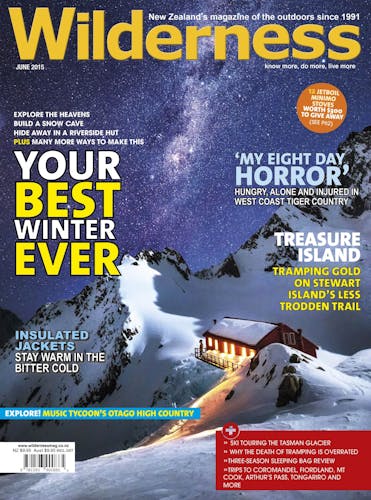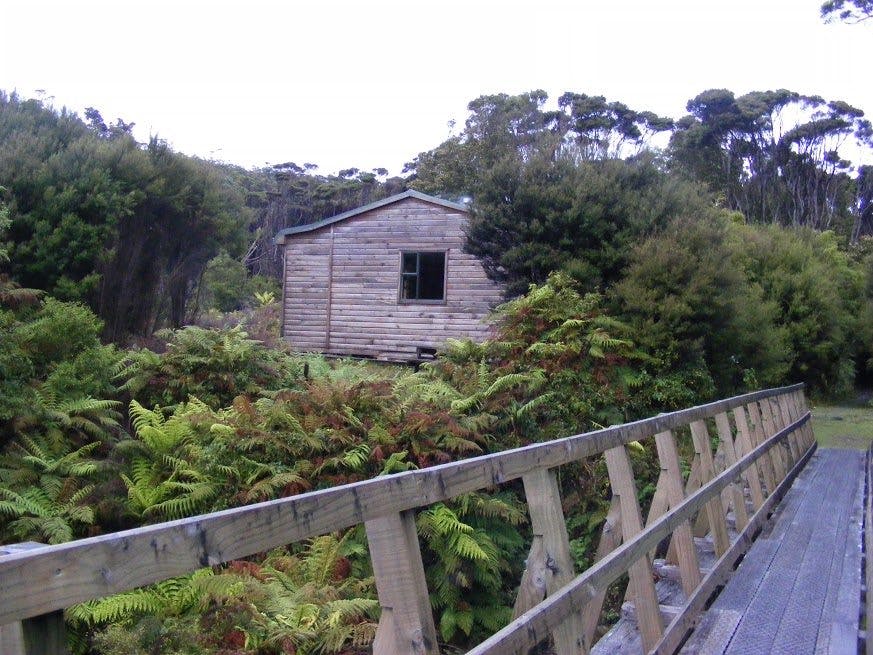- Area
- Fiordland National Park
- Distance
- 33km to Wairaurahiri River
- Time
- Rarakau to Port Craig 5-7hr; Port Craig to Percy Burn Hut 1.5 to 2 hr; Percy Burn Hut to Wairaurahiri Hut 2.5 to 3 hr
- Grade
- Easy/Moderate
- Accom.
- Port Craig School Hut, 20 bunks; Wairaurahiri Hut, 14 bunks; Percy Burn Hut, 18 bunks
- Access
- 28km west of Tuatapere
- Map
- CG07, CG06
Percy Burn Hut, Fiordland National Park
For me, the Waitutu Forest was a case of love at first sight. A big trip here in 1982, which encompassed the tops of the Hump Ridge, Wairaurahiri Valley’s towering forests and dark mysterious river, the history of Port Craig and its tramway, and the beaches of Te Waewae Bay spurred me to come back time and again.
My friend Barry and I, each with one teenage son, headed through regrowth forest along the clifftop before a steep descent took us on to Bluecliffs Beach. It took a good hour to get from the Waikoau River to the western end of the beach, and then a short walk on the remains of the road to the boundary of Fiordland National Park and the start of the track proper.
As much of the South Coast Track is now part of the Hump Ridge Track, it’s seen quite a bit of development in recent years, and the legendary mud is largely no more. So, a quick walk took us to the bridge over Pipi Tuariki Stream (known locally as Flat Stream), past the turnoff to the ascent to Okaka Hut and down onto Blowhole Beach. Genuine blowhole activity is rare, but on a stormy day the rock platforms just offshore can create some spectacular effects. The track crosses a couple of small headlands, which can be bypassed at low tide, before reaching O Hoka Stream.
This is the decision point for choosing a low tide route along the stunning beach or what was once a hideously muddy and hour-longer inland route. It was obvious we’d have to take the inland route which has, fortunately, benefited greatly from the upgrades, and it probably only takes 20-minutes longer than the beach these days.
We were at Port Craig shortly after 1pm, so took a break in the old schoolhouse hut. Then it was time to take a poke around the remains of the mill site and the port. Hector’s dolphins are often seen frolicking off Mussel Beach, but not today.
A little over an hour saw us at the Sand Hill Viaduct, and in a another 10 minutes we were at Percy Burn, the site of probably the largest surviving wooden viaduct in the world. It’s 125m long and 36m high. The viaduct is now closed and an alternative track has been built through the gully.
The Trust that did a lot of work on the viaducts built a hut at Percy Burn, principally as a work base but also as a recreational facility. It’s one of my favourite huts, with 18 bunks around a single room, and a wetback feeding a shower. It makes a comfortable home for the night.
The following morning, we took a short walk down to the beach at the mouth of Percy Burn. It’s a rugged, stony beach that sweeps 8km from Sand Hill Point to the Wairaurahiri River, and it’s a grand place to be. Returning to the hut, we collected our packs and marched the final two and half hours along the tram track to the DOC hut on the banks of the Wairaurahiri. On the way, we crossed the viaducts at the Edwin Burn, which marks the junction with the Hump Ridge Track, and the Francis Burn.
After lunch at the hut, a swing bridge (complete with possum-proof gate) took us across the river, where it’s 10 minutes downstream to Waitutu Lodge, a slightly more upmarket alternative to the DOC hut. Here we met Johan from Wairaurahiri Jet, who was to take us to Lake Hauroko and on to our car, which he had moved to his base in Clifden.
The run up the Wairaurahiri is an experience in its own right. I was delighted to get to see the river I’d walked down all those years ago. The podocarp forests that comes right to the river’s edge were impressive, and it’s easy to see why this was one of the two key places that spurred my interest in recreational and environmental advocacy.
The ride up the river took nearly an hour, including slowing down from time to time to check Johan’s network of stoat traps, and then it was a rough trip across a wind-swept Lake Hauroko to conclude a great trip.








